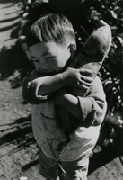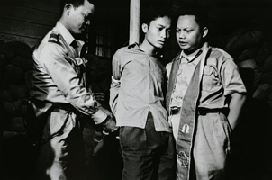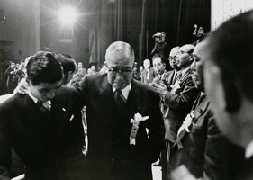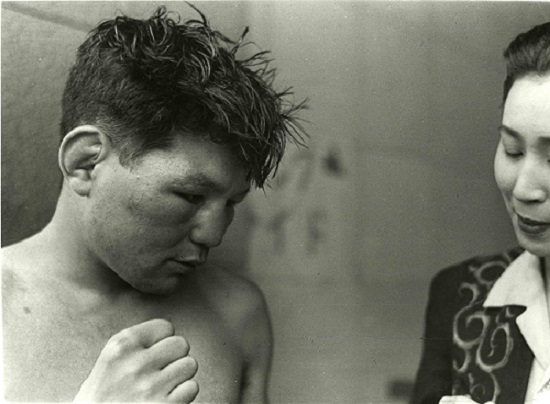Press Photographers’ Story
May. 16—Jul. 5, 2009
- May. 16—Jul. 5, 2009
- Closed Monday (Tuesday if Monday is a national holiday)
- Admission:Adults ¥500(400)/College Students ¥400(320)/High School and Junior High School Students, Over 65 ¥250(200)
They were both journalists and artists.
These star press photographers’ story is a tale of creative freedom!
Even today, in a world flooded with press photographs, a single shot can touch us to the quick. An image of an everyday scene, a scoop captured where no one has set foot before, the decisive moment at which one era ends and another begins: in their universality and their beauty, these photographs transcend “communicating” or “recording” information to grip our very souls. This exhibition spans the Showa Era (1926-1989), treating the pre-war, wartime, and post-war years as a single period. It is focused on five star press photographers, each with a powerful creative sensibility: Kageyama Koyo, Ohtsuka Gen, Yoshioka Senzo, Funayama Katsu, and Akimoto Keiichi. All were pillars of the Asahi Shimbun newspaper. In addition to the photographs they produced for their employer, they also contributed work defined by their vigorous characters as auteurs to magazines produced by other publishers, enjoying the same creative freedom in their activities as freelance photographers. The ways in which they transcended the conventional limits associated with the label “newspaper staff photographer” were truly remarkable and especially evident during the periods that they were associated with the Asahi Shimbun. This exhibition is, then, an opportunity, while examining the central question of the mission of press photography, to consider other issues as well. What was the system that provided the context in which these photographers worked? Was it an environment free from restrictions that gave birth to such richness of expression? To explore these issues from the perspectives of photojournalism and the photographer as auteur, we have assembled a wide range of work, with some 180 photographs, mainly from the museum’s collection, scheduled to be displayed. These include images by Kageyama and Ohtsuka added to the collection during fiscal 2008 and now displayed for the first time as well as a wide range of other work from the collection.
① Follow these press photographers’ stories!
This exhibition presents a wide range of photographs from the museum’s collection, works that range from creative masterpieces to photos that were taken as these press photographers went about their everyday jobs. Kageyama Koyo captured the decisive moment of the meeting between Generals Yamashita and Percival that marked the fall of Singapore in 1942. He also created the album The Life of Little Yotchan, compiled as a memorial to his son, who died at the age of five, which provides a remarkable photographic record of his family. Ohtsuka Gen not only took impersonal news photographs. He also produced unique examples of photomontage and was the individual chiefly responsible for defining the distinctive style of the newspaper’s “Photography and Culture” section, of which he was in charge. These are only two examples of the remarkable stories that press photographers, who have not been much in the limelight, were responsible for--stories told in this exhibition through a wealth of their creative work.
② Newspaper publisher photography and photograph publishing divisions
Early in the Showa Era, newspaper publishers began to create photography divisions as independent units staffed by photographers. The Asahi Shimbun, which created its photography division in 1929, was a pioneer in this process. Until then, newspapers had purchased photographs from photoengraving companies. With outstanding photographers on staff, however, they could obtain photographs of highly professional quality, quickly. At the time, publication of press photographs was not restricted to newspapers. They also appeared in weekly magazines and illustrated magazines such as Asahi Graf, which were the core media for presenting photographs. The illustrated and weekly magazines’ schedules allowed more time for shoots than did newspapers, and they also published series of photographs organized around particular themes. They thus provided press photographers with opportunities to expand their creative range. Here, while exploring the division of labor between the photography and photograph publishing divisions at newspapers, we focus on the critical roles played by both.
③ Historic newspapers and magazines
This exhibition includes, with the photographs, many examples of the newspapers and magazines in which these photographs were actually published.Ohtsuka Gen, Yoshioka Senzo, and Funayama Katsu, for example, published a host of outstanding photographs in the “New Tokyo” and “Modern Sentiments” series that ran in the magazine Asahi Camera. In Ohtsuka’s work we see a continuing battle between the anonymity of the photographs he produced for the newspaper and his authorial presence, for self-expression was of paramount concern to Ohtsuka. This exhibition presents his outstanding sensibilities as creative artist and art director through examples of the publications in which his work appeared in print.


KAGEYAMA Koyo, Yotchan with a Sweet Potato on His Shoulder, from The Life of Little Yotchan November,1948
AKIMOTO Keiichi, Shoot to Kill-The Death of a High School Student, 1965


YOSHIOKA Senzo, Departure of Hatoyama, from the Contemporary Passions 1956
FUNAYAMA Katsu, Korakuen at Night, from Tokyo 1950s



![チラシ1[pdf]](http://topmuseum.jp/upload/4/199/thums/2009_010_press.png)
![出品作品リスト1[pdf]](http://topmuseum.jp/upload/4/199/thums/press02.png)